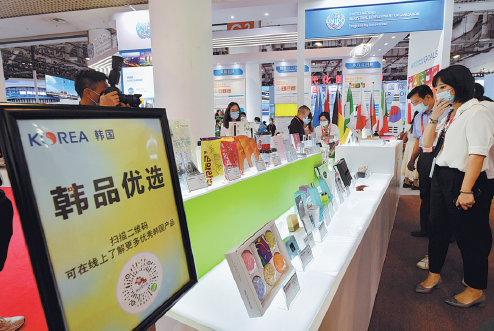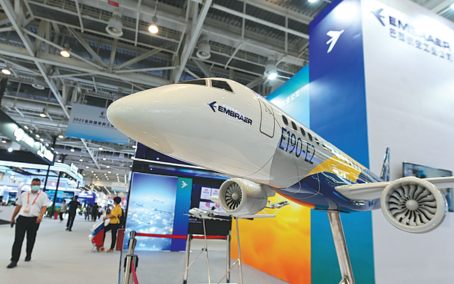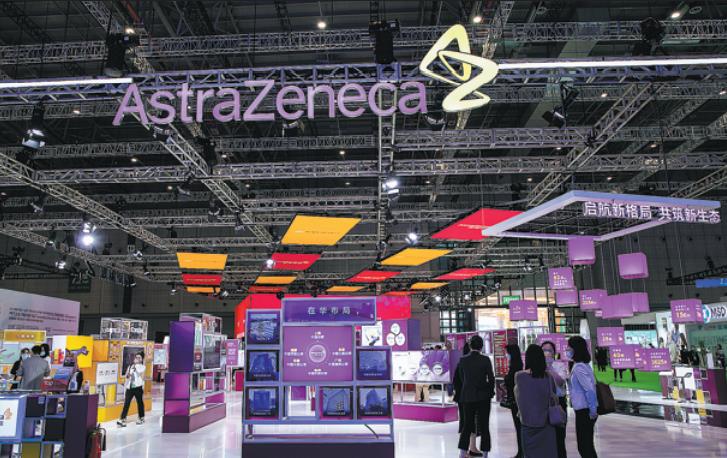


More and more foreign firms, investors swear by China's economic prospects

When Canada's Alex Zhavoronkov established drug discovery company Insilico Medicine in 2013 with artificial intelligence as the driver of its operations, he based the company's major research and development facility in Shanghai. Its key corporate offices are based in both Hong Kong and New York.
The business-friendly climate of Shanghai, China's coastal economic hub, he figured out, will aid the high-tech startup's growth and development.
Zhavoronkov, now CEO of Insilico, knew Shanghai is rich in top AI talent, high-quality services from local contract research organizations, or CROs, an energetic entrepreneurship culture, and constantly improving regulatory environment.
Shanghai, he said, lived up to the expectations. Insilico has nominated eight preclinical drug candidates since 2021, which were discovered or designed using its proprietary AI platform in a variety of disease areas, including fibrosis, inflammation and cancer.
Besides, the company's first AI-discovered drug candidate, for the treatment of a rare and chronic lung disease called idiopathic pulmonary fibrosis, has finished dosing subjects for a phase-1 clinical study in China.
"With the preclinical cell and animal experiments conducted in multiple CROs in Shanghai and nearby, we could rapidly iterate our artificial intelligence systems and make rapid progress in pipeline research and development," he said.
With an initial investment of $1 million in the Shanghai R&D facility, Insilico had increased the facility's registered capital to $20 million by the end of July.
Insilico is a fine example that China remains one of the preferred destinations of foreign investors despite myriad challenges and uncertainties.
More such examples shone brightly at the 22nd China International Fair for Investment and Trade, which concluded on Sept 11 in Xiamen, Fujian province.
More than 480 project deals with a combined investment value of 342 billion yuan ($49.11 billion) were signed at the fair.
The four-day event attracted more than 800 industrial and trade groups, more than 4,000 enterprises and about 60,000 business people from over 90 countries and regions online and offline, a record in terms of the combined number of participants and visitors.
The latest data from the Ministry of Commerce showed foreign direct investment in China was worth 798.33 billion yuan in the first seven months of the year, up 17 percent year-on-year.

The robust growth came against a backdrop of multiple external and internal negatives, including geopolitical tensions and industrial and supply chain inconveniences caused by the recent domestic COVID-19 resurgence.
Experts and business leaders said thanks to China's unwavering commitment to opening-up and reform, as well as its firm pursuit of innovation-driven high-quality development, the domestic market has been expanding while its business environment constantly improved and its weight in global industrial chain increased. It is an ongoing process and that makes the nation increasingly attractive to foreign investors, they said.
The nation should adhere to such development approach and make more efforts to propel development of high-tech and services, in order to create more market opportunities for foreign investors and boost FDI, they said.
They also predicted the nation can sustain high-level FDI inflows throughout the year this way despite various headwinds.
"Some people may worry that foreign investment will flow out of China. Such worries are groundless, as the FDI growth has shown us," said Wang Jingwen, director of the Macro Research Center affiliated to the China Minsheng Bank Research Institute.
"There is consensus among foreign enterprises that investing in China is investing in the future," he said.
The US additional tariffs on Chinese goods have increased enterprises' costs of buying products from China, and some countries may seek to reconstruct industrial and supply chains to reinforce their supply stability. Despite that, foreign investors remain enthusiastic about investing in China after weighing their options, Wang said.
Data from the MOC showed the number of the newly established foreign-funded enterprises in China has been rising over the years. The figure rose to 48,000 in 2021, up 23.5 percent from a year ago.
The paid-in FDI in China exceeded 1.1 trillion yuan in 2021, increasing nearly 15 percent year-on-year.
Although some foreign-funded enterprises have relocated their production facilities to other regions outside China in recent years, the number of such enterprises is quite limited and many more foreign enterprises still chose to keep investing in China, analysts said.
Zhang Jianping, head of the center for regional economic cooperation at the Chinese Academy of International Trade and Economic Cooperation, said that while many foreign companies eye the nation's huge domestic market potential and, therefore, increase investment in China, a rapidly growing number of foreign companies invest more in China because they are impressed by the country's rising position in the global supply chain.
For those companies, China can offer an environment that facilitates development, efficiency and close coordination from upstream and downstream industries, he said.
He also observed much of FDI in China flows into services, thanks to higher-level opening-up in the sector, while high-tech industries and high-end manufacturing have also attracted increasingly more foreign investment.
That will help propel the Chinese economy's transition toward the higher value-added end to ensure stable economic upgrade and growth, he said.

PPG, one of the world's largest suppliers of paints, coatings and specialty materials, launched its global power battery fire protection coatings production line at a Wuhu plant in Anhui province in June. The annual production capacity of the plant is expected to reach 20,000 metric tons by this year-end, including 1,100 tons of fire protection coatings for power batteries.
Raymond Siu, chief financial officer and interim president of the US-based company's arm in the Asia-Pacific region, said: "As the world's largest manufacturer, China continues to lead with the most comprehensive and resilient supply chain system, and offers foreign investors huge growth opportunity as the second-largest consumer market.
"The more multinationals know about and integrate their operations into the economy of China, the more confidence they will have in China's long-term growth and prosperity."
In 2021, PPG started building a global innovation center in Tianjin to focus on technology development and innovation not only for the China market but for the Asia-Pacific and other regions around the globe where PPG has operations.
With a total investment of $80 million, the facility in Tianjin is the only innovation center outside of PPG's global headquarters and is expected to be operational in 2023.
The company is also setting up its Battery Pack Application Center in China focusing on electric vehicle battery technology innovation.
According to Zhang Yansheng, chief researcher at the China Center for International Economic Exchanges, China must propel high-quality development and make more efforts in developing high-tech manufacturing and services sectors, to boost FDI inflows.
"As China pursues economic transformation and industrial and supply chain upgrades, it will remain attractive to foreign investments," Zhang said.
Wang with the China Minsheng Bank Research Institute also said foreign investors are keen to tap the opportunities arising from China's economic transformation and upgrades, which is reflected in their increasing enthusiasm for investing in China's high-tech and modern services sectors.
Official data showed actual use of foreign capital in the services sector surged 10 percent year-on-year in the first seven months to 598.92 billion yuan, accounting for around 75 percent of the total FDI inflows.
The FDI growth rates for high-tech industry, high-tech manufacturing and high-tech services came in at 32.1 percent, 33 percent and 31.8 percent, respectively, much higher than the overall FDI growth.
Wang Lei, global executive vice-president of AstraZeneca and president of international business and China operations, said an increasing number of multinational companies are seeing China as an important innovation source and manufacturing base instead of seeing the nation only as a major market.
"Building global research and development centers, innovation facilities and industrial parks in China has become a new trend among multinational pharmaceutical companies," he said.
For instance, AstraZeneca has formed cooperation arrangements with partners, including the Wuxi high-tech industrial development zone, to build the MCampus in Wuxi, Jiangsu province, an industrial park focused on developing solutions to metabolic diseases.
Serving as an open ecosystem for clinical and industrial integration, the MCampus aims to help Wuxi city to upgrade its healthcare industry and create a life science innovation cluster with metabolic disease diagnosis and treatment at its core.
In the next five years, the MCampus plans to bring in and nurture 50 companies, recruit 500 high-end professionals from different fields, launch 50 products, generate product sales of 2.5 billion yuan, and have five new companies listed on stock exchanges.
liuzhihua@chinadaily.com.cn
If you have any problems with this article, please contact us at app@chinadaily.com.cn and we'll immediately get back to you.